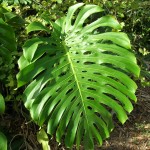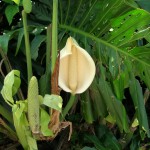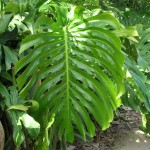Swiss Cheese Vine (Monstera deliciosa)
Fewer plants have a stranger appellation than Monstera deliciosa, but at least the name is half right! This sturdy aroid has been described by one prominent botanist as “probably the finest foliage plant ever introduced into horticulture.” But it is even more than that, because it produces a delicious fruit that combines the tastes of pineapple, banana and even mango! The vine was introduced to England in 1752, but in the indirect way by which many tropical plants became distributed around the planet, the fruit of Monstera, despite the species’ New World origin, did not debut in the United States until 1874.
As for the name Monstera, the origin is a little fuzzy. Some believe that an ancient Greek term for aroids, Dracontium, meaning dragon or snake, was transformed into a French equivalent which later emerged in its Latin form as Monstera; others speculate that the name comes from the Latin word denoting a wonder or an exceptional thing. We may never be certain, but what isn’t in dispute is the beauty of the plant. While the leaves of a young M. deliciosa are solid and heart-shaped, giving no early clue to any exceptional qualities, as the plant develops, the glossy, symmetrical leaves become much larger, split at the edges, and develop holes, often oblong, near the center. The mature leaf gives rise to the species’ widely-known common name, Swiss Cheese Plant. Under ideal conditions, the leaves of Monstera can exceed 3 ft. in length.
Monstera is a liana, i.e., a woody vine, native from Mexico to Panama, which in the wild may reach 70 ft., climbing trees to reach into the rain forest canopy. Surprisingly, a newly-germinated seedling initially does not grow toward the light. Instead it moves toward darker areas of the forest until it hits the base of a tree which will become its host. Only after attachment to the tree will it climb toward the light. Later on, aerial roots descend from the Monstera vine high in the air to the ground.
But M. deliciosa does not need to be grown only as a liana in the landscape. Its versatility allows it to be maintained as an impressive mid-size hedge. One of its best applications is to soften fences or walls at the edges of a property, and it possesses a wide range of light and water tolerance once established.
Like many aroids, when M. deliciosa is mature enough to flower, it produces an off-white, boat-shaped bract, known as a spathe, which surrounds an upright spike, known as a spadix. In a slow-motion process, the pollinated spadix matures into an aromatic fruit that bears a mild resemblance to a corn cob. The “cob” bears hard green, hexagonal, cap-like scales that cover the fruits. The scales begin to pop off the fruits as they ripen. The rule of thumb is that last year’s fruits begin to ripen about the time this year’s flowers start to appear. Monstera fruits are not only eaten fresh, but are used to flavor beverages, jams, baked goods, ice cream. sauces, stir fries and syrups. (Please note: Prying the scales off to eat fruits which haven’t ripened naturally is inadvisable, since immature fruits contain calcium oxalates, which will irritate the mouth and throat.)
In spite of Monstera’s tropical origins, it makes a wonderful houseplant, tolerant of low humidity and light watering. About the only thing it won’t do indoors is to fruit. M. deliciosa is available at Richard Lyons’ Nursery as field-grown plants and in 3-gal. and 7-gal. containers.


